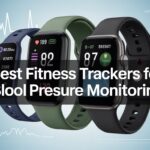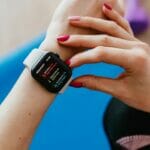We’ve all stared at our fitness trackers and wondered why the blood pressure reading just sits there, frozen. We poke at menus, tap the screen, even reboot, hoping something will change. Most fitness trackers can’t measure blood pressure because their sensors just aren’t made for it.

If you’ve already scrolled through all your settings and still can’t find a blood pressure option, you’re not alone. The tech just isn’t there yet.
Plenty of trackers, like Fitbit models, don’t offer this feature, even though the ads make it look like we’re living in the future. We all want our wrists to do more, but until the tech catches up, we’re left guessing whether that last cup of coffee was a mistake.
Honestly, it’s kind of funny how we expect so much from a tiny gadget that sometimes can’t even tell us tomorrow’s weather. Blood pressure tracking would be amazing, but there are bigger reasons it’s not happening yet—and it’s definitely not because we missed an update.
How Fitness Trackers Measure Vital Signs
We trust our fitness trackers for quick health stats. But not all numbers are easy to get.
Our devices handle heart rate and pulse pretty well. Blood pressure, though, is a different animal—and a tricky one.
The Science Behind Heart Rate Tracking
Most trackers use photoplethysmography (PPG) to measure heart rate. That’s just a technical way of saying the watch shines a little green light into our skin and checks how blood flow changes the reflection.
When the heart beats, blood flow increases, and the light reflects differently. Trackers catch these changes and tell us our heart rate.
Is it painless? Absolutely—unless you count the stress of seeing a high number. It’s quick and doesn’t need cuffs or nurses.
But just because our wrists light up like a disco doesn’t mean they can track everything. Heart rate and pulse are simple; blood pressure, not so much.
How Pulse and Blood Pressure Are Different
Pulse and blood pressure aren’t the same—honestly, they’re barely related. Pulse just counts how many times our hearts beat per minute.
Blood pressure is sneakier. It measures how hard our blood pushes against artery walls as it moves through us. While trackers can spot the heart beating, they can’t tell if the blood is flowing gently or pounding away.
Real blood pressure checks usually need a cuff that squeezes our arm. Most smartwatches skip this—unless you find one of those rare models with a mini inflatable cuff in the band. Even then, studies like this one say they’re not perfect.
So, while we obsess over our step count, we still need the old-school arm cuff for accurate blood pressure.
Why Most Fitness Trackers Don’t Measure Blood Pressure
Fitness trackers do a great job counting steps and tracking heart rates. But blood pressure? That’s a whole different story.
There are a few solid reasons our wrists just aren’t the best spots for accurate blood pressure readings.
Sensor Technology Limitations
Let’s be real: our trackers love to flash lights and make us feel like James Bond. But under the hood, most of these gadgets just aren’t built for blood pressure.
Standard trackers use optical sensors to measure heart rate. They shine light into our skin and watch the blood flow, but this method works best for pulse—not pressure.
Unlike real blood pressure monitors that squeeze our arms with a cuff, trackers don’t have a way to measure actual pressure. Some newer models claim to measure blood pressure, but they still need to be calibrated with a real monitor. Even then, results can be all over the place.
As people mention on Reddit, most trackers only estimate heart rate using reflected light—not blood pressure.
Challenges with Blood Pressure Accuracy
Blood pressure is a finicky thing to measure. Our bodies can mess up readings if we move, talk, or even sneeze at the wrong moment. Dedicated monitors use cuffs to control these conditions tightly.
Fitness trackers just sit on our wrists. The tiniest change in strap tightness or position can throw off the numbers. And if we don’t keep our wrists at heart level, the data can be as wrong as a weather app in April.
Trackers also struggle with calibration. Even fancy smartwatches that advertise blood pressure features need to be checked against a real monitor, as articles like this one point out.
If we forget to calibrate, our readings can drift into fantasyland.
So unless our tracker has a tiny inflatable cuff (which it doesn’t), it’s just not built for reliable blood pressure monitoring.
Troubleshooting Your Fitness Tracker
Fitness trackers can be confusing, especially with advanced health features like blood pressure. Let’s look at why our trackers might act up and what they actually can—or can’t—do.
Misleading Features and Marketing
We’ve all fallen for slick marketing. Sadly, most fitness trackers do not measure blood pressure, even if the box makes it sound like they do.
Some track heart rate, which isn’t the same as blood pressure—kind of like how toast isn’t bread, even if they’re related.
Manufacturers sometimes throw around terms like “blood health” or “SpO2 sensors,” and we start connecting dots that aren’t really there. In reality, regular trackers measure heart rate and maybe blood oxygen—not blood pressure.
If we dig into the details, we’ll see many trackers—including Fitbit—just don’t have the sensors for blood pressure, as explained in this post about no blood pressure monitoring.
Before buying, double-check the specs. Don’t let those glossy product photos with smiling, healthy people trick us into thinking we’re getting a medical device on our wrist.
Common Device Glitches
Let’s talk about glitches. Even if a tracker measures heart rate and other stuff, it’s not always perfect.
If we see weird numbers or missing data, a few things might be going on. Loose fits, dirty sensors, or worn-out wristbands are often the culprits.
Here’s a quick checklist:
- Tighten your tracker: It should be snug, but not cutting off circulation.
- Clean the sensors: Use a soft cloth, nothing fancy.
- Restart the device: Sometimes a quick reboot helps.
- Update the app: Outdated software can cause weirdness.
Some glitches just come with the territory. If you’re still having trouble, check out tips for tracking issues on smartwatches.
And if your tracker claims to measure blood pressure but never works? It probably never could.
When You Need a Dedicated Blood Pressure Monitor
Sometimes, the latest fitness tracker just isn’t enough—especially if you really need accurate blood pressure numbers. If you have high blood pressure or health concerns, it’s smart to upgrade from a high-tech bracelet to a real medical device.
Differences Between Fitness Trackers and Medical Devices
Let’s be honest: fitness trackers are like that friend who tries hard at trivia but just guesses most of the answers.
They mostly estimate blood pressure, using sensors meant for heart rate or movement—not for serious medical monitoring.
Medical blood pressure monitors are like calculators—built for the job, tested, and reliable. These dedicated devices use inflatable cuffs to measure the actual pressure in our arteries.
Most health guides, like Consumer Reports, point out that wearables just aren’t perfect for blood pressure readings. Many need calibration with a real monitor, and even then, you can throw them off by moving too much or wearing them wrong.
Honestly, nobody wants to base health decisions on a tracker that thinks tying your shoes burns 200 calories.
Choosing the Right Tool for Blood Pressure Readings
When it comes to blood pressure, guesswork isn’t good enough. If your doctor says you need to track your blood pressure, you need a tool you can trust.
That usually means an upper-arm cuff bp monitor, or sometimes a wrist monitor that’s actually approved for accuracy.
Before buying, ask yourself: Is it easy to use? Can you read the display without squinting? Does it store past results or sync to your favorite app?
Here are some quick tips:
- Get a monitor with an adjustable cuff that fits your arm.
- Look for clear displays (no one likes squinting).
- Pick one with memory storage so you can track your numbers over time.
- Check for validation from groups like the American Heart Association.
A dedicated blood pressure monitor is much less likely to embarrass you with a wild number just because you sneezed or cheered for your team.
Future Outlook: Will Fitness Trackers Ever Replace BP Monitors?
Let’s be honest—most of us want our fitness trackers to do everything, from counting steps to predicting what’s for dinner. But blood pressure? That’s a tougher nut to crack. Can these stylish gadgets ever really replace a classic BP monitor?
Emerging Technologies in Wearables
Wearables are getting fancier all the time. Instead of those awkward arm cuffs that make us feel like we’re about to launch a rocket, we now have smartwatches and trackers trying to read blood pressure with sensors and algorithms.
Some models try to use light and new tech to estimate BP, even without a cuff. Fitbit and Apple are both working on it.
But even top-of-the-line models can’t give us real systolic and diastolic numbers like the old-school devices. Maybe future tech will change that, but for now, these wearables just aren’t ready to replace the classic monitors. You can dive deeper in this article on new wearable tech.
What to Look Forward to (and What to Ignore)
Let’s be real—if you’re expecting six-pack abs overnight, you’ll probably end up disappointed. Some wearables claim they can “measure” your blood pressure, but honestly, these numbers often feel like educated guesses.
Right now, most smartwatches only show you trend data. They don’t deliver medically accurate BP readings.
When you’re shopping around, just skip any device that claims it can replace a traditional BP monitor. Instead, try to find gadgets with FDA clearance, or at least ones that work with cuff-based monitors if you want numbers you can actually trust.
Honestly, fitness trackers make great supporting actors. But would I trust them to headline when it comes to my blood pressure health? Not a chance.
- Best Bluetooth Headphones for Airplane Travel: Drown Out Crying Babies in Style - December 8, 2025
- How to use Bluetooth headphones with an intercom system and Finally Escape Tangled Wires - December 7, 2025
- Best Fitness Trackers for Silent Alarms: Wake Up Without the Drama - December 7, 2025






